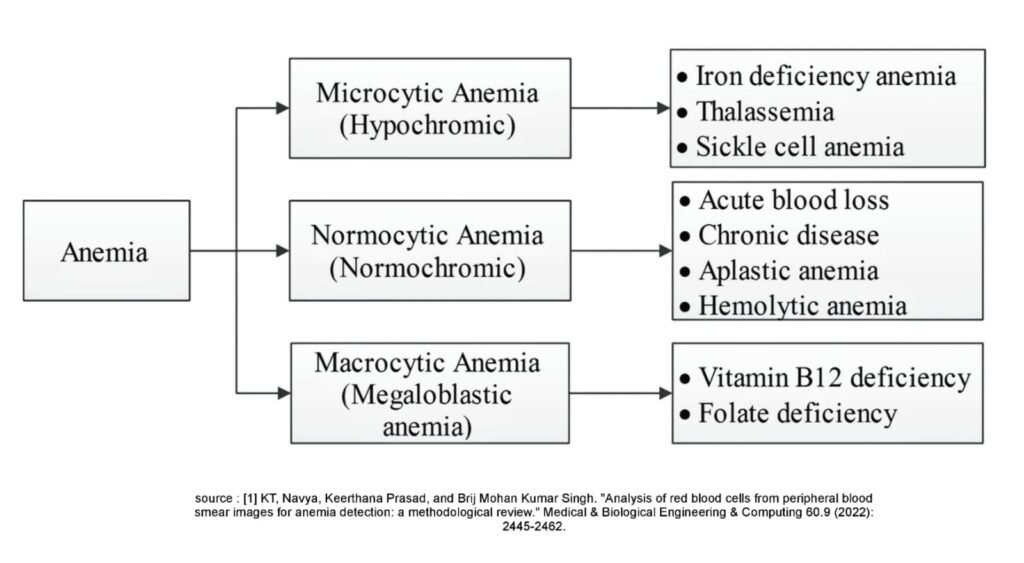Anemia: A prevalent yet discounted health situation
Anemia is a medical condition in which a person has a lower than normal amount of red blood cells or hemoglobin in their blood. Hemoglobin is the protein in red blood cells that carries oxygen from the lungs to the rest of the body. Without enough hemoglobin, the body’s tissues and organs may not receive enough oxygen to function properly.
Anemia can be caused by a variety of factors, including a deficiency in iron, vitamin B12, or folate, chronic diseases such as kidney disease or cancer, or inherited disorders such as sickle cell anemia. Symptoms of anemia can include fatigue, weakness, shortness of breath, dizziness, and pale skin. Treatment depends on the underlying cause of the anemia and may involve dietary changes, supplements, or medication.
Anemia is a global health problem that affects people of all ages, genders, and socioeconomic backgrounds. According to the World Health Organization (WHO), an estimated 1.62 billion people worldwide suffer from anemia, which is about 24.8% of the global population. Iron-deficiency anemia is the most common type of anemia, affecting an estimated 1 billion people worldwide. Anemia is more common in women than in men, with an estimated 29.4% of non-pregnant women and 38.2% of pregnant women affected. Anemia is a leading cause of maternal mortality and morbidity, particularly in low- and middle-income countries. Children under the age of 5 are also at high risk of anemia, with an estimated 47% of this age group affected worldwide.
There are several types of anemia, which are classified based on the underlying cause of the condition [1] [2]. Some of the most common types of anemia include:
1-Iron-deficiency anemia: This is the most common type of anemia and occurs when the body does not have enough iron to produce hemoglobin. Iron-deficiency anemia can be caused by a poor diet, blood loss, or an inability to absorb iron from food.
Treatment : This type of anemia is typically treated with iron supplements, which can be taken orally or through intravenous injection. It is also important to consume iron-rich foods such as red meat, dark leafy greens, and fortified cereals.
Oral iron supplements : Oral iron supplements are available in various forms, such as ferrous bisglycinate, ferrous sulfate, ferrous gluconate, and ferrous fumarate.
It is important to take iron supplements as directed by a healthcare provider, as taking too much iron can be toxic. Common side effects of iron supplements include constipation, nausea, vomiting, and stomach pain. To minimize side effects and maximize absorption, it is recommended to take iron supplements on an empty stomach, with vitamin C-rich foods or supplements to enhance absorption.
It is also important to note that iron supplements may interfere with the absorption of certain medications, such as antibiotics and thyroid medications. Therefore, it is important to inform a healthcare provider of any other medications being taken before starting an iron supplement regimen.
2- Vitamin-deficiency anemia: This type of anemia is caused by a deficiency in either vitamin B12 or folate, which are both essential for the production of red blood cells. Vitamin-deficiency anemia can be caused by a poor diet, malabsorption disorders, or certain medications.
Treatment : Treatment for this type of anemia typically involves supplementation with vitamin B12 or folate. It is also important to consume foods rich in these vitamins, such as meat, fish, and leafy green vegetables.
3- Hemolytic anemia: This type of anemia occurs when red blood cells are destroyed faster than they can be produced. Hemolytic anemia can be caused by inherited conditions, autoimmune disorders, or certain medications.
Treatment : Treatment for this type of anemia depends on the underlying cause, but may include medications to suppress the immune system, blood transfusions, or removal of the spleen.
4- Aplastic anemia: This is a rare type of anemia that occurs when the bone marrow is unable to produce enough red blood cells. Aplastic anemia can be caused by exposure to toxins, certain medications, or an underlying autoimmune disorder.
Treatment : Treatment for this type of anemia may include medications to stimulate the bone marrow, blood transfusions, or stem cell transplantation.
5- Sickle cell anemia: This is an inherited type of anemia that occurs when the red blood cells are shaped like crescents or sickles, which can cause them to get stuck in blood vessels and block blood flow.
Treatment : Treatment for this type of anemia may include pain management, antibiotics to prevent infections, blood transfusions, or bone marrow transplantation.
6- Thalassemia: This is an inherited type of anemia that occurs when the body is unable to produce enough hemoglobin. Thalassemia is more common in people of Mediterranean, African, and Asian descent.
Treatment : Treatment for this type of anemia may include blood transfusions, iron chelation therapy to remove excess iron from the body, or bone marrow transplantation.

Iron supplementation may be necessary for COVID-19 patients who have been diagnosed with anemia due to iron deficiency. However, it’s important to use iron supplementation with caution in COVID-19 patients, as excessive iron intake can potentially worsen the infection.
Some studies have suggested that iron may promote the growth and replication of some viruses, including the SARS-CoV-2 virus that causes COVID-19 [4]. Therefore, the decision to prescribe iron supplementation should be based on the individual patient’s needs and circumstances and should be made by a qualified healthcare provider.
The treatment for anemia in COVID-19 patients will depend on the severity of the anemia and the underlying cause. In general, treatment for anemia may include:
- Iron supplementation: If the anemia is due to iron deficiency, iron supplements may be prescribed to increase the production of red blood cells.
- Blood transfusion: In severe cases of anemia, a blood transfusion may be necessary to replenish the red blood cell supply.
- Treat underlying medical conditions: If the anemia is caused by an underlying medical condition, such as kidney disease or a chronic infection, treating that condition may improve the anemia.
- Oxygen therapy: In some cases, oxygen therapy may be necessary to increase the amount of oxygen in the body and improve the symptoms of anemia.
If you have been diagnosed with COVID-19 and have been prescribed iron supplementation for anemia, it’s crucial to follow your healthcare provider’s instructions closely and to monitor your symptoms carefully. Be sure to discuss any concerns you may have about taking iron supplements with your healthcare provider, who can help you make an informed decision about the risks and benefits of this treatment option.
- Sonnweber, Thomas, et al. “Persisting alterations of iron homeostasis in COVID-19 are associated with non-resolving lung pathologies and poor patients’ performance: a prospective observational cohort study.” Respiratory research1 (2020): 1-9.
- Taneri, PetekEylul, et al. “Anemia and iron metabolism in COVID-19: a systematic review and meta-analysis.” European journal of epidemiology35 (2020): 763-773.
- Cavezzi, Attilio, EmidioTroiani, and Salvatore Corrao. “COVID-19: hemoglobin, iron, and hypoxia beyond inflammation. A narrative review.” Clinics and practice2 (2020): 1271.
- Roldan, Eugenia Quiros, et al. “The possible mechanisms of action of 4-aminoquinolines (chloroquine/hydroxychloroquine) against Sars-Cov-2 infection (COVID-19): A role for iron homeostasis?.” Pharmacological research158 (2020): 104904.
